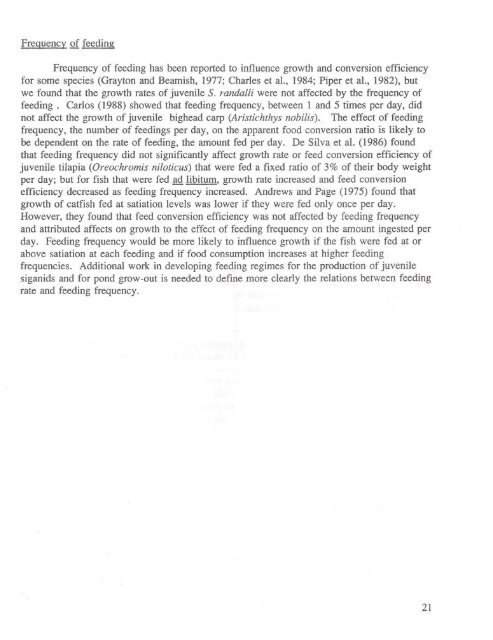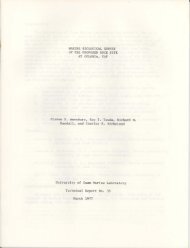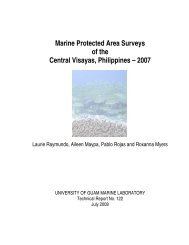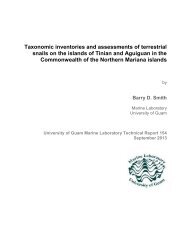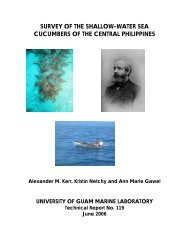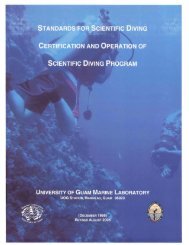Frequency <strong>of</strong> feedingFrequency <strong>of</strong> feeding has been reported to influence growth and conversion efficiencyfor some species (Grayton and Beamish, 1977; Charles et aI., 1984; Piper et aI., 1982), butwe found that <strong>the</strong> growth rates <strong>of</strong> juvenile S. <strong>randalli</strong> were not affected by <strong>the</strong> frequency <strong>of</strong>feeding. Carlos (1988) showed that feeding frequency , between I and 5 times per day, didnot affect <strong>the</strong> growth <strong>of</strong> juvenile bighead carp (Aristichthys nobilis). The effect <strong>of</strong> feedingfrequency, <strong>the</strong> number <strong>of</strong> feedings per day, on <strong>the</strong> apparent food conversion ratio is likely tobe dependent on <strong>the</strong> rate <strong>of</strong> feeding, <strong>the</strong> amount fed per day. De Silva et al. (1986) foundthat feeding frequency did not significantly affect growth rate or feed conversion efficiency <strong>of</strong>juvenile tilapia (Oreochromis niloticus) that were fed a fixed ratio <strong>of</strong> 3% <strong>of</strong> <strong>the</strong>ir body weightper day; but for fish that were fed ad libitum, growth rate increased and feed conversionefficiency decreased as feeding frequency increased. Andrews and Page (1975) found thatgrowth <strong>of</strong> catfish fed at satiation levels was lower if <strong>the</strong>y were fed only once per day.However, <strong>the</strong>y found that feed conversion efficiency was not affected by feeding frequencyand attributed affects on growth to <strong>the</strong> effect <strong>of</strong> feeding frequency on <strong>the</strong> amount ingested perday. Feeding frequency would be more likely to influence growth if <strong>the</strong> fish were fed at orabove satiation at each feeding and if food consumption increases at higher feedingfrequencies. Additional work in developing feeding regimes for <strong>the</strong> production <strong>of</strong> juvenilesiganids and for pond grow-out is needed to define more clearly <strong>the</strong> relations between feedingrate and feeding frequency.21
FIELD GROWTH TRIALSTo allow farmers an opportunity to evaluate <strong>the</strong> growth <strong>of</strong> <strong>rabbitfish</strong> in ponds, juvenileS. <strong>randalli</strong> produced in <strong>the</strong> hatchery were provided to two commercial fish farms on Guam.Two <strong>of</strong> <strong>the</strong> ponds <strong>of</strong> Inarajan Aquaculture Enterprises (rAE) were stocked. These ponds werealso being used for culturing milkfish. One pond belonging to Liu Island farm was alsostocked. This pond was also being used for <strong>the</strong> experimental culture <strong>of</strong> grey mullet MugUcephalus. Because <strong>of</strong> mass mortalities in <strong>the</strong> culture ponds, in one case (Liu Island farm) asa result <strong>of</strong> low oxygen content and in ano<strong>the</strong>r (IAE) as a result <strong>of</strong> a typhoon, only one <strong>of</strong> <strong>the</strong>pond growth trials was successful. The trial and its results are described below.MATERIALS AND METHODSInarajan Aquaculture Enterprise, a fish farming operation owned by Mr. George Tsai,was provided with 1400 juvenile siganids, ranging from 4.7 to 10.0 cm in standard length, onSeptember II, 1990. The fish were stocked in a pond that was being used for <strong>the</strong> culture <strong>of</strong>milkfish. The procedures used in <strong>the</strong> culture <strong>of</strong> milkfish on Guam have been describedpreviously (Nelson, 1990). Fishes in <strong>the</strong> ponds were fed with <strong>the</strong> commercial feed formulatedfor catfish, <strong>the</strong> same feed as that used in <strong>the</strong> tank culture trials described above. A sample <strong>of</strong>60 fish was taken <strong>the</strong> day before <strong>the</strong>y were stocked in <strong>the</strong> pond. The standard length <strong>of</strong> eachfish was measured to <strong>the</strong> nearest millimeter, and each fish was weighed on an electronicbalance to <strong>the</strong> nearest 0.1 gram.The fish were harvested for transfer to ano<strong>the</strong>r pond on December 5, 1990, and at thistime, a sample <strong>of</strong> 20 fish was collected, and <strong>the</strong> individual fish were measured and weighed.A typhoon (Typhoon Russ) in December 1990 caused severe damage to <strong>the</strong> sou<strong>the</strong>rnarea <strong>of</strong> Guam, and all <strong>of</strong> <strong>the</strong> fish in <strong>the</strong> IAE ponds were lost. The losses included <strong>the</strong>siganids that had been previously stocked in one pond and those that had been recentlysampled and transferred. Therefore, we were able to obtain data for only one relatively shortgrow-out period.RESULTSThe samples <strong>of</strong> fish stocked and harvested are described by <strong>the</strong> statistical summaryshown in Table 13. The fish averaged 6.09 cm in standard length and 9.46 g in weight atstocking and averaged 14.5 cm in standard length and 100.23 g in weight at harvest. The fishwere smaller at harvest than most siganids found in <strong>the</strong> markets on Guam; but, even so, <strong>the</strong>ywere <strong>of</strong> marketable size, as evidenced by <strong>the</strong> fact that <strong>the</strong>y were all sold from <strong>the</strong> rAE retailoutlet less than 30 minutes after <strong>the</strong>y were made available to consumers. The pond owner,Mr. Tsai, commented that, in his opinion, <strong>the</strong> growth <strong>of</strong> <strong>the</strong> siganids was acceptable forcommercial production. He also noted that <strong>the</strong> siganids in <strong>the</strong> pond were smaller and less22


